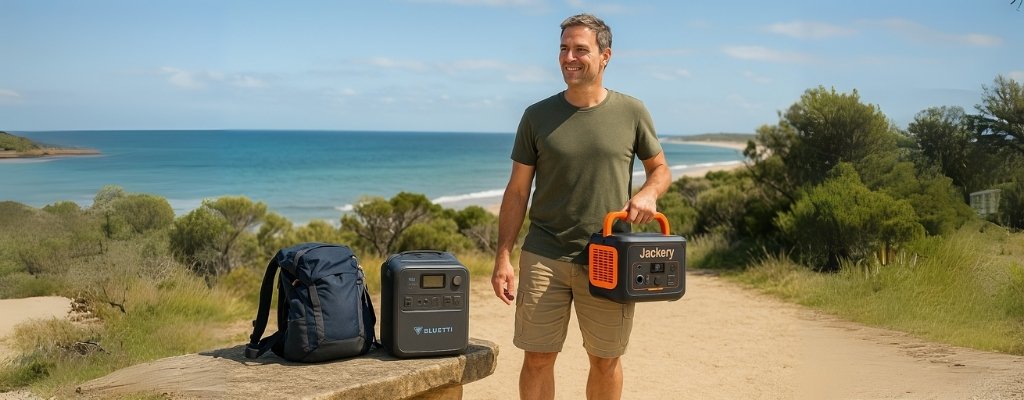
Bluetti AC180 vs Jackery 1000 V2
Choosing between the Bluetti AC180 and Jackery 1000 V2 portable power station?
Short answer: the AC180 has more capacity, the Jackery wins on portability.
But when you factor in weight, charging speeds, and how you’ll actually use it in Australia, the decision gets more interesting. Let’s look at how each stacks up in real-world use.
Not sure which power station is right for you?
Take the quiz!
What’s the Difference in Core Performance and Specifications: Bluetti AC180 vs Jackery 1000 V2 Portable Power Station
Battery Capacity and Longevity of Your Portable Power Generator
Nominal Watt-Hours and LiFePO4 Chemistry
The AC180 comes in at 1152Wh, while the Jackery 1000 V2 sits at 1002Wh.
The AC180 uses LiFePO4 battery chemistry, which is stable and built for the long haul. The Jackery uses lithium-ion NMC, which is lighter but generally has a shorter cycle life.
Charge Cycles and Expected Lifespan
The AC180 will give you over 3,000 charge cycles before dropping to 80% capacity.
The Jackery 1000 V2 averages closer to 1,000 cycles.
For regular use, the Bluetti will keep its performance longer, while the Jackery is better suited to occasional outings.
Power Output and Charging Capabilities of the Portable Power Generator
Continuous and Surge AC Output for Various Appliances
Both models deliver 1800W continuous output, but surge capacity tells a different story.
The AC180 can surge up to 2700W, which helps when starting heavy-draw appliances like fridges or power tools. The Jackery 1000 V2 peaks at around 2000W, fine for most everyday needs.
AC Charging Speed and Time to Full Charge
The AC180 hits 80% in about 45 minutes using its turbo AC charging.
The Jackery 1000 V2 fully charges in roughly 1.7 hours, still quick enough to get ready for an afternoon trip.
Solar Input Efficiency and Maximum Wattage
The AC180 accepts up to 500W of solar input, which is handy for multi-day camping or off-grid setups.
The Jackery 1000 V2 tops out around 400W solar input, still capable but a little slower in peak Aussie sunshine.
DC Charging Speed and Options
Both units can be charged via a car outlet while driving.
The AC180 also works well with a generator, making it versatile for backup use during outages.

Comparing Design, Portability, and Smart Features: Bluetti AC180 vs Jackery 1000 V2 Portable Power Stations
Physical Design and Portability of the Portable Power Generator
Weight, Dimensions, and Handle Design
The AC180 weighs around 17–18kg.
The Jackery 1000 V2 is lighter at just 11.5kg.
That weight difference makes Jackery the easier carry, especially for frequent trips. Its rounded handle is comfortable for one-handed carrying, while Bluetti’s side handles work better for lifting.
Build Quality and Ruggedness
Both feel solid and reliable.
The AC180 has a more rugged, industrial look. The Jackery has a sleek, curved design that feels more at home at picnics and weekend getaways.
Neither is water-resistant, so both need a dry spot if the weather turns.
Connectivity, Ports, and User Experience of the Portable Power Generator
Available AC, USB, and DC Output Ports
The AC180 offers 3 AC outlets, 4 USB-A, 1 USB-C PD, and DC outputs.
The Jackery 1000 V2 includes 3 AC outlets, 2 USB-A, 2 USB-C, and DC outputs.
The extra USB-C on the Jackery is a plus for modern devices.
Wireless Charging Capabilities
The AC180 has a 15W wireless charging pad on top, great for topping up a phone without hunting for cables.
The Jackery doesn’t include wireless charging, focusing instead on its ports.
App Control (Wi-Fi vs. Bluetooth) and Display Features
The AC180 connects to an app via Bluetooth for remote monitoring.
The Jackery doesn’t offer app control but has a clear, easy-to-read display built in.
UPS Functionality and Transfer Speed
The AC180 can work as a UPS, switching quickly to keep devices running during power cuts.
The Jackery doesn’t include UPS capability, so it’s better for planned use rather than emergency switching.

Making Your Decision: Bluetti AC180 vs Jackery 1000 V2 - Which Portable Power Station is the Right Fit?
Ideal Use Cases and Scenarios for Each Portable Power Generator
Best Generator for Higher Output and More Ports
The AC180 is the better choice for heavier loads, more outlets, and long-term use. It suits off-grid cabins, extended camping trips, and running multiple high-demand appliances.
Top Generator for Portability, Faster AC Charge, and More Charge Cycles
The Jackery 1000 V2 is lighter, quicker to carry, and fast to charge from AC. It’s a strong choice for short trips, beach days, and anyone prioritising portability.
Value Proposition and Long-Term Investment in Your Portable Power Generator
Comparative Pricing and Cost-Benefit Analysis
Pricing in Australia is close. The Jackery is usually slightly cheaper, but the AC180’s lifespan and features often justify the higher price.
Warranty and Customer Support Considerations
Both brands offer strong local warranty support—typically around 5 years for Bluetti and 3–5 years for Jackery depending on the retailer.


